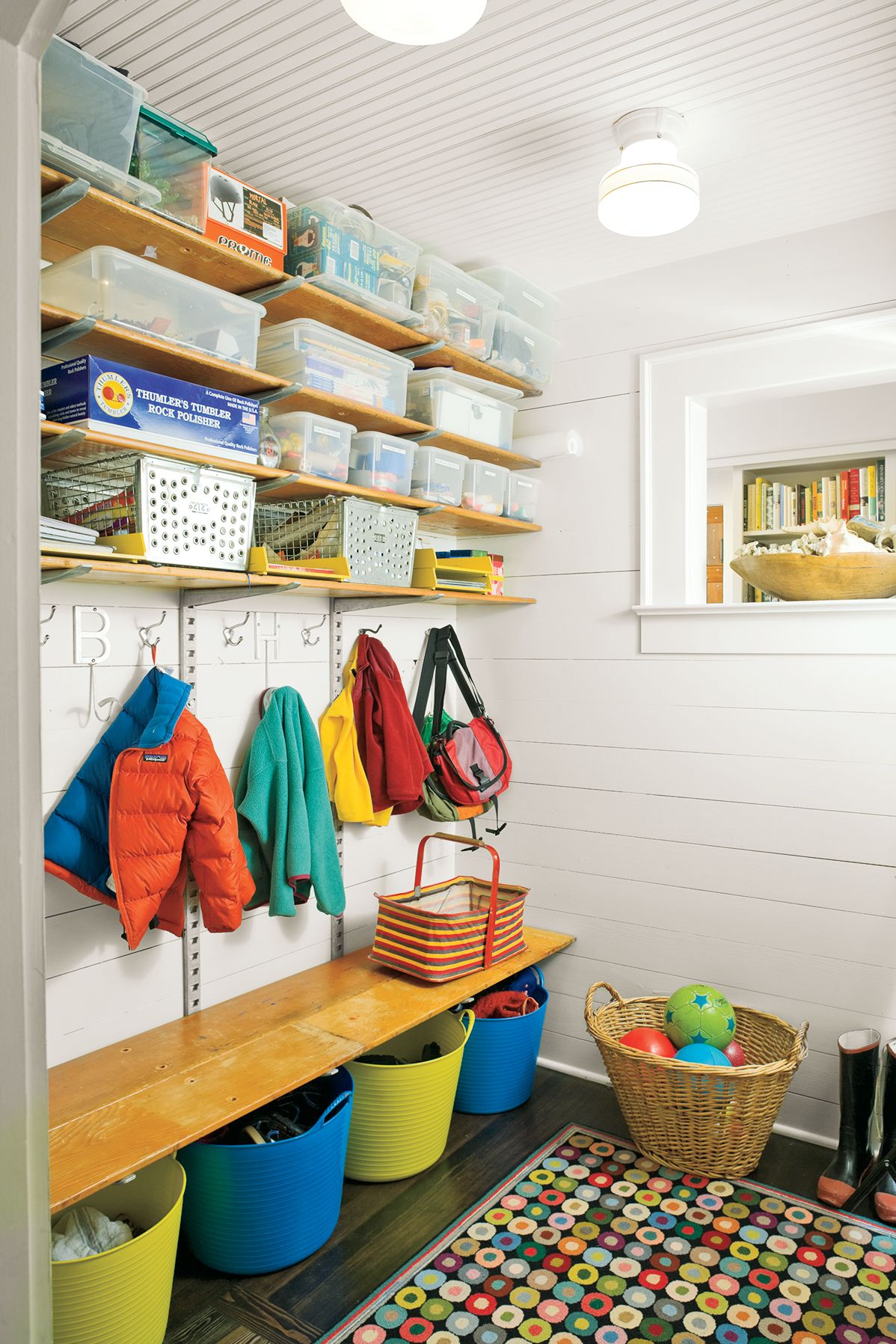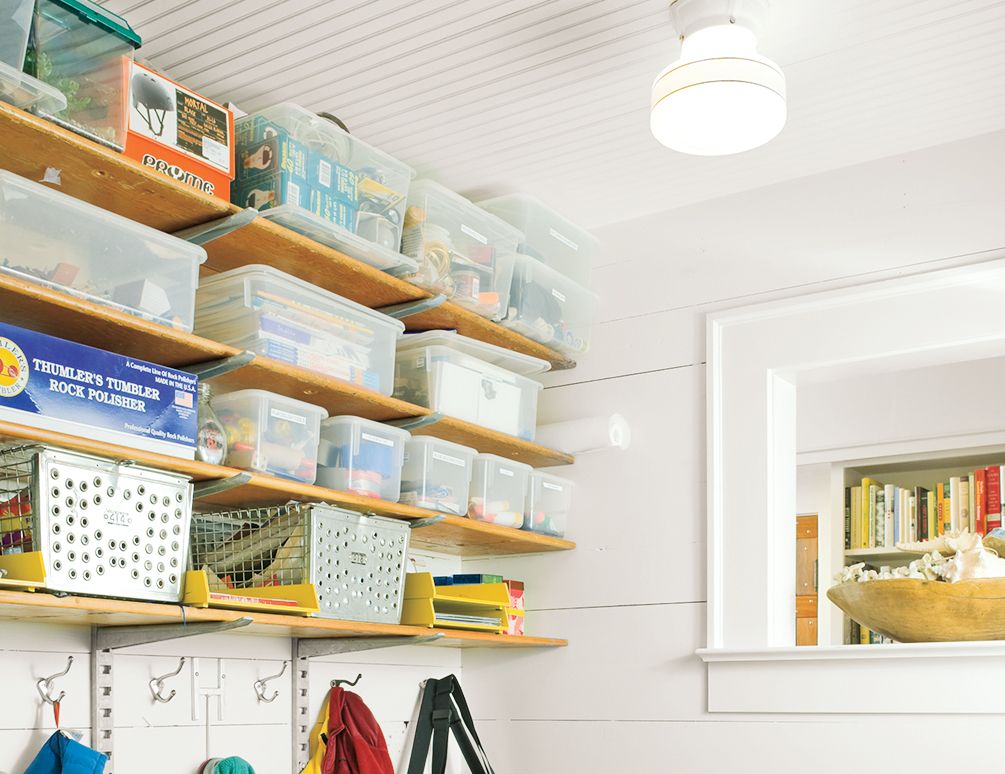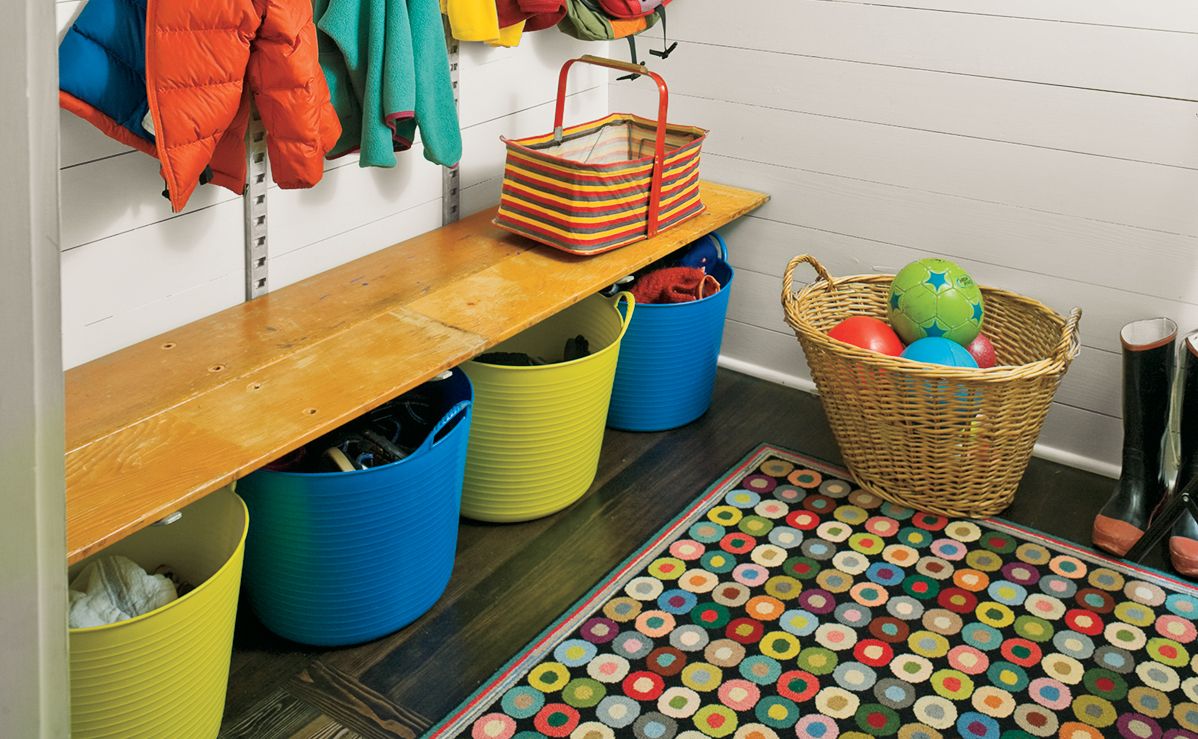Creating an organized mudroom is a game-changer for busy families during the back-to-school season. This functional space is great for containing clutter and streamlining daily routines. A mudroom acts as a transitional space and provides a designated area for family members to remove and store shoes, coats, and backpacks. During the school year, a mudroom offers a centralized location for school supplies, sports equipment, and seasonal gear, which can reduce stress during hectic mornings and after-school hours. In this guide, we’ll explore how to transform your entryway into an efficient, organized mudroom that meets your family’s needs.

Here, one family incorporated fun details to effectively and inexpensively bring order to what had been a toy- and school-supply-strewn backdoor entry off their kitchen.
Key Elements of an Effective Mudroom
Let’s explore the key components that make a mudroom practical and appealing.
Storage Solutions
Storage is the cornerstone of any well-designed mudroom. Incorporating various storage options ensures that every item has its place, reducing clutter and making it easier to find what you need quickly. Consider these storage solutions:
- Baskets or bins for smaller items
- Cubbies or lockers for each family member
- Hooks for coats, bags, and accessories
- Wall-mounted shelving units

A wall-mounted unit like this one, made from metal standards, adjustable brackets, and shelves fashioned from salvaged school bleachers, is an easy and thrifty way to add multiple levels of stowaway space.
Seating Options
Incorporating seating in your mudroom provides a comfortable spot for putting on or removing shoes. Consider a built-in bench with storage underneath or a freestanding bench or chair. In smaller spaces, you can use fold-down seating.
For a budget-friendly option, create a DIY bench using two shelves or lengths of reclaimed wood placed side by side on sturdy brackets. This approach offers seating and storage space beneath.
Durable Flooring Choices
Mudroom flooring should be able to withstand heavy foot traffic, moisture, and dirt. Opt for materials that are easy to clean and maintain. Some popular flooring options include the following:
- Ceramic or porcelain tiles: These tiles are durable and waterproof, which makes them perfect for handling the moisture and dirt typical of a mudroom. They are also easy to clean and come in a wide range of designs and colors.
- Indoor/outdoor carpeting: Designed to withstand moisture and dirt, indoor/outdoor carpeting can add warmth and comfort to a mudroom while being easy to clean. It’s available in a variety of patterns and colors.
- Sealed concrete: This option provides a sleek, modern look and is highly durable and resistant to moisture and stains when properly sealed. It’s a great choice if you want a low-maintenance, cost-effective flooring solution.
- Vinyl tiles or planks: These are durable, water-resistant, and easy to clean, making them ideal for mudrooms. They come in various styles and can mimic the look of wood or stone.
If you’re working with existing wood floors, protect them with a durable area rug.
Designing Your Mudroom for Maximum Functionality
When designing your mudroom, focus on maximizing space and creating a layout that works for your family’s needs.
Optimizing Wall Space
Make the most of your mudroom’s vertical space by incorporating wall-mounted storage. This approach keeps the floor clear and makes it easier to clean. Consider these ideas:
- Install hooks at various heights for coats, bags, and accessories.
- Mount shelves above hooks for additional storage.
- Use pegboards for flexible storage options.

To guard against wear, sheathe drywall in wood paneling painted with a heavy-duty semigloss. Mimic the rustic look of the horizontal treatment above by stacking tongue-and-groove floor planks.
Creating Designated Zones
Organize your mudroom into distinct zones to help family members quickly locate their belongings. By creating these zones, you’ll help establish a sense of order and make it easier for everyone to maintain the space:
- A designated area for seasonal gear
- A shared space for frequently used items
- A spot for pet supplies, if applicable
- Individual storage areas for each family member
Incorporating Personal Touches
Adding personal touches to your mudroom makes the space more inviting while catering to your family’s needs. Consider these ideas:
- A chalkboard or whiteboard for notes and reminders
- Family photos or kids’ artwork on display
- Personalized hooks or cubbies for each family member
Mudroom Organization Tips for Back-to-School Success
As the school year begins, implement organization strategies to keep your mudroom functioning smoothly throughout the year.
Use labels to designate spaces for each family member and specific items. This system helps everyone know where things belong and makes tidying up easier. Use chalkboard labels for easy updating, and create picture labels for younger children. You can use color coding to differentiate between family members.
Regularly rotate seasonal items to ensure that your mudroom remains organized and clutter-free. Store out-of-season items in labeled bins or boxes to keep them out of the way.
Mudroom Maintenance Year-Round
Encourage all family members to participate in mudroom maintenance tasks. Wipe down surfaces and sweep or vacuum the floor weekly. Wash rugs and mats regularly, and declutter and reorganize monthly.
Adapting Your Mudroom for Different Seasons
You can adapt your space to accommodate seasonal items and activities with these tips:
- Spring: Store rain gear and lightweight jackets. Consider adding hooks or a dedicated shelf for umbrellas and rain boots to keep wet items organized and prevent water from dripping onto the floor.
- Summer: Create space for beach towels and sunscreen. Install baskets or cubbies near the entrance for easy access to flip-flops, hats, and other outdoor essentials. Add a small shelf or hanging rack for swimsuits and wet items to dry quickly.
- Fall: Organize school supplies and sports equipment. Set up cubbies or bins labeled for each child to keep backpacks, lunch boxes, and school projects organized. A designated rack or storage bin can hold soccer balls, cleats, and other sports gear.
- Winter: Make room for bulky coats, boots, and snow gear. Install sturdy hooks or a coat rack that can handle the weight of heavy winter coats. Place a boot tray or mat near the door to catch melting snow and slush.
You can also update your decor seasonally to keep your mudroom feeling fresh and welcoming. Add seasonal artwork or prints, or change out throw pillows or rugs to match the season.
Our Conclusion
An organized mudroom is a great home upgrade for the back-to-school season. By incorporating versatile storage, comfortable seating, and durable flooring, you can create a functional space that streamlines your family’s daily routines.
Your mudroom should evolve with your family’s needs. Regularly reassess and adjust your organization systems to ensure they continue to serve you well. With thoughtful planning and maintenance, your mudroom will remain a valuable asset to your home.
